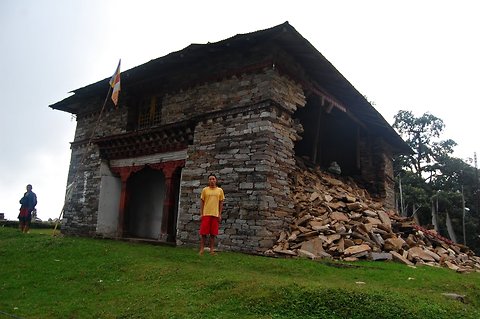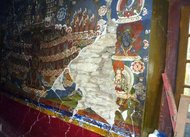Rattled Heritage: Sikkim’s Monasteries after the Quake
A solidly written consideration of the effects on Buddhist monasteries of the recent earthquake in Sikkim, with reference to recent architectural practices in the region. – Buddhist art news

Hongdi monastery in Sikkim, built in the early 17th century.Suraj GurungHongdi monastery in Sikkim, built in the early 17th century.
The New York Times, January 23, 2012, 1:53 am
By CHETAN RAJ SHRESTHA
For a week after the Sept. 18 earthquake, many towns in Sikkim were cut off from the outside world. The roads slowly became passable and as they did, photographs and video clips began to circulate. Rumors traveled too, especially that the major monasteries – Pemayangtse, Dubdi, Tashiding and Ringhim – were barely standing and that some of the smaller monasteries in Khechiperi and Hongdi had been obliterated.
The truth has proven more reassuring. There was damage, but not outright destruction. However, it is clear that the monasteries, chief items in Sikkim’s meager architectural heritage, were the hardest hit buildings in the quake.
After the earthquake, the Cultural Affairs and Heritage Department undertook a survey in Sikkim’s four districts. I visited some monasteries alone, some with local officials, and was given information on others. I also assisted with a report summarizing these assessments that covered 121 religious and cultural properties.
Some trends were apparent. Recent concrete and brick monasteries fared well unless poorly constructed. The older stone and mud monasteries, some of which date back to the early 1700s, were badly affected. Walls had collapsed completely, roofs detached from walls and internal murals were scarred by cracks. A gradual analysis identified four main reasons for the damages: local intensity of the quake, soil subsidence, shoddy construction and age.

A mural which suffered cracks, at the Chungthang Monastery, Sikkim.Chetan Raj ShresthaA mural which suffered cracks, at the Chungthang Monastery, Sikkim.
Much of the damage was done by two forces – intensity and subsidence. The quake’s magnitude was 6.8, but distributed unequally in Sikkim. In the north, where it was most severe, reinforced concrete monasteries in Chungthang and Lachung were rattled enough to be declared unstable. Subsidence has the greatest potential for long-term danger. The earthquake could be seen as a 35-second repositioning of the mountains and even now reports are coming in of monasteries, such as Ralang in South Sikkim, where cracks are still widening.
What will happen during the monsoon season, when rainwater pours into a loosened mountainside, should but has not caused apprehension among the authorities and the monks.
Proportionately speaking, amateur construction appears to have contributed little to the general damage. But in terms of what it indicates and presages, it is the most worrying. In recent decades, nearly all the monasteries have been constructed or repaired by the monks themselves. “Contract lamas,’’ as they are called, are common in Sikkim. They propose projects, are paid and execute the work in between their religious duties, or sometimes at their expense. The government, anxious to please a powerful constituency, does not interfere.
Some contract lamas are perhaps thinking, with some wistfulness, of the central government’s pledge to “reconstruct’’ Sikkim with a special focus on its monasteries. This relief package is by now mythically generous. Its largesse fluctuates between 2.5 billion rupees (about $49 million) and 10 billion rupees (about $199 million) . But nothing has arrived until now; four months after the quake.
The monks will determine whether the older monasteries, so crucial to an understanding of Sikkim’s architectural history, will be restored or torn down and rebuilt. They will have to choose between demolition and conservation, with persuasions from both sides. Chawang and Hee Gyathang in North Sikkim are two monasteries whose committees have chosen to restore the masonry buildings which were damaged on September 18.
Stone masonry monasteries were the hardest hit, suffering all the effects of a crippling accident in old age. Loose stones, weak mortar and decaying wood members contributed to an overall frailty. But physical evidence and oral records testify that they were regularly rebuilt after disasters like the January 1934 Great Bihar earthquake and the June 1897 Great Assam earthquake, both of which affected Sikkim.
When rebuilding happens now, though, convenience is often the deciding factor. The obvious inflictions on the stone facades of the older monasteries – broken walls, collapsed altars – are contrasted with the relative health of the concrete monasteries and presented as proof of the older monasteries’ weakness. That some of them have stood for a few centuries means little.
A century is an eon in Sikkim. Indians sometimes seem to shrug while treating their relics with cheerful disregard; they contend there is a surfeit of history in India. But Sikkim lacks that dubious luxury. Here, mythical history is abundant, recorded history is recent and tangible heritage is scarce.
Sikkim was annexed into the Indian union in 1975, an act commonly called the “merger.’’ It brought Sikkim statehood and with it, regular and substantial funds from the central government. Most of the newer monasteries date from after 1975, either constructed on new land or to replace older structures.
The Buddhist scriptures do not provide guidelines for concrete constructions, and it is uncertain where the contract lamas acquired their knowledge. Inspections after the quake revealed absurdly bad building practices – beams larger than their supporting columns, improperly cured concrete, inadequate reinforcement. The older masonry monasteries were almost always built by the monks and laity, but they used materials – timber, stone, thatch – that they were familiar with. It is their unfamiliarity with concrete that opens the way for amateur construction and material corruption.
The monks’ fondness for concrete led them to dismantle much of their own heritage over the past two decades. The new monasteries are often built on the site of the previous structures for the opposing reasons of sanctity – the footprint of the existing monastery is itself considered holy – and convenience – the debris is often cannibalized to abet new construction.
This insensitivity is not limited to Sikkim. Tawang, a 400-year-old monastery in Arunachal Pradesh state and the largest one in India, has only one original building. The Dalai Lama reportedly admonished the monks of the ancient Dhankar Monastery, in Himachal Pradesh state, asking them to conserve rather than rebuild, a directive they heeded. His Holiness ought to turn his disapproving gaze eastwards.
Part of the present ugliness in monastic construction may have a bitter root. Sikkim has historically looked up to Tibet for political and religious guidance. After the closure of the Tibet border in 1962 following the Indo-China war, the artery between Sikkim and its cultural heart was severed, and it was isolated from discourses in monastery conservation. There is a nascent admiration for Bhutan, which shares Sikkim’s paucity of heritage items but which has shrewdly managed a sensitive conservation of its monastic heritage.
Competition is common among monasteries in Sikkim. In an attempt to upstage each other, some institutions have replaced stone with bricks, mud with cement, timber with marble. Where marble cannot be obtained, they prefer bathroom tiles, the more luridly colored the better.
If desire is the cause of suffering, as Buddhism holds, how much sadness must there be in the smaller monasteries in Sikkim, which aspire to the opulence achieved by the larger ones? It shows the monks as distressingly human, tormented by the same impulses that beset the laity.
Chetan Raj Shrestha is an architect currently practicing in Sikkim. He specializes in conservation architecture and writes in his spare timesourse:BUDDHIST ART NEWS

No comments:
Post a Comment